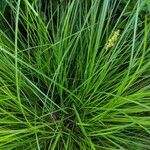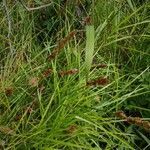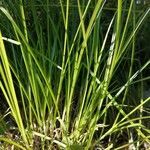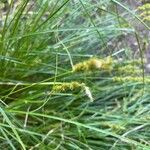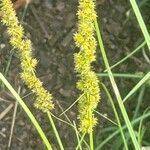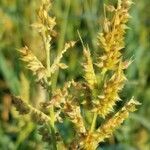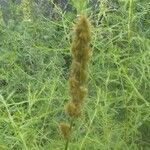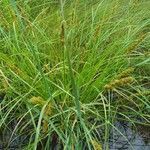Dense stiff clumps, 50-80 cm high. Stems firm, erect, sharply 3-angled, harshly scabrid on angles just below inflorescence. Leaves usually > stems, 2-5 mm wide, ± flat, strongly scabrid; sheaths long, membranous, transversely-rugulose for 2-4 cm below mouth. Inflorescence a very dense, ± cylindrical, ± lobed, spiciform panicle 6-10 × ± 1 cm, green to light brown. Spikes numerous, sessile, very crowded above, lower ones more distant with setaceous bracts < inflorescence, male flowers at top of spikes, female flowers densely crowded. Glumes much < utricles, ovate with far excurrent midrib. Utricles 2-2.5 × 1.5 mm, ovate, plano-convex, faintly nerved on convex face, tapering to a narrow bifid beak ± 1 mm long with sparsely scabrid margins. Stigmas 2. Nut almost spherical, biconvex.
Culms to 100 cm × 2 mm, scabrous. Leaves: sheath fronts spotted red-brown or pale brown, apex truncate or short-convex, membranous or hyaline, rugose; ligule retuse or rounded, to 2 mm, free limb to 0.2 mm; blades 120 cm × 5 mm, longer than flowering stem. Inflorescences spicate, (3–)7–10 cm × 15 mm, with 10–15 branches, the proximal branches distinctly separate; the proximal internode to 25 mm; bracts setaceous, those subtending at least the proximal lateral branches conspicuous. Scales pale brown, hyaline, awn to 3 mm. Perigynia green to pale brown, veinless on both faces or 3-veined abaxially, body ovate or elliptic, 2–3.2 × 1.3–1.8 mm, base obtuse; beak 0.8–1.2 mm, 1/3–1/2 length of perigynium. Achenes red-brown, ovate, 1.2–1.4 × 1 mm, glossy. 2n = 52.
